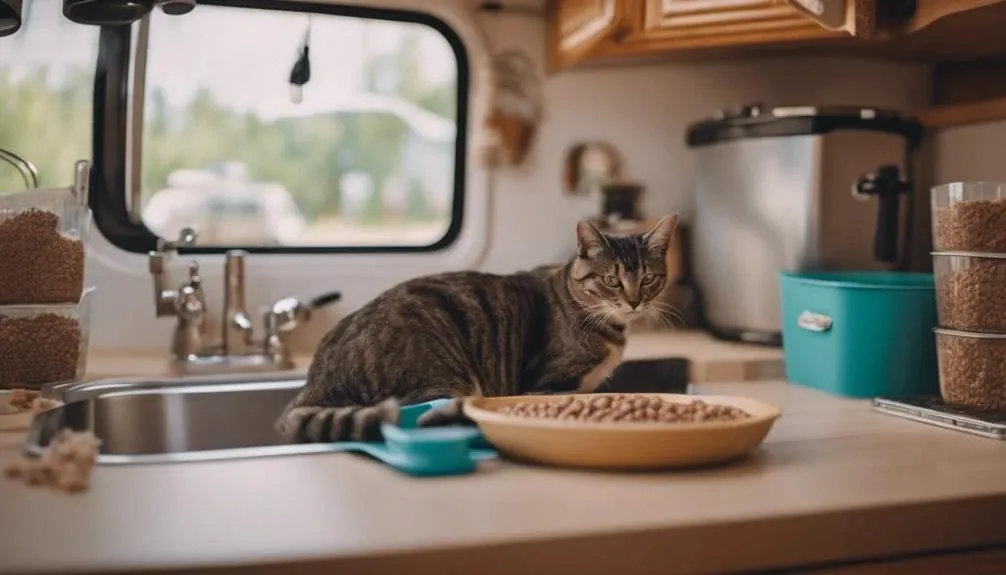The Best Fluffy Pancakes recipe you will fall in love with. Full of tips and tricks to help you make the best pancakes.

When it comes to living in an RV with your cat, remember that 'home is where the heart is.' Navigating this unique lifestyle with your feline companion requires thoughtful planning and consideration.
From creating a safe environment to ensuring their comfort on the road, there are essential tips that can make this adventure a smooth one for both you and your cat.
So, how can you ensure a harmonious living situation in a confined space while exploring new horizons together?
Key Takeaways
- Plan driving routes with frequent stops and consider calming aids for comfort.
- Maintain a consistent supply of fresh food, water, and monitor intake for health.
- Provide cozy resting spots, hiding options, and monitor temperature for comfort.
- Create designated hiding spots in the RV, like under furniture or shelves, for your cat's safety and comfort.
Driving Plan
When living in an RV with your cat, creating a structured driving plan is essential to ensure both safety and comfort during travel. Start by planning your driving route with frequent stops to allow your cat to stretch, use the litter box, and stay hydrated. Securing your cat in a comfortable carrier or a designated spot within the RV will help ensure their safety while you're on the move.
Driving short distances initially can assist your cat in acclimating to the motion and sounds of the RV, reducing potential stress and anxiety. To further enhance your cat's comfort during travel, consider using calming aids such as pheromone sprays or treats. Maintaining a comfortable temperature within the RV and avoiding sudden loud noises will also contribute to a more relaxed environment for your furry companion.
Litter Box Placement
To ensure your cat's comfort and ease of access, strategically placing the litter box in a designated area within your RV is crucial. Cats are creatures of habit and require a consistent spot for their litter box to avoid confusion.
Here are some essential tips for litter box placement in your RV:
- Consistency is Key: Choose a specific location for the litter box and stick to it to provide familiarity for your cat.
- Cleanliness is Crucial: Keep the litter box clean to reduce stress and maintain your cat's hygiene during travel.
- Monitor Bathroom Habits: Regularly monitor your cat's bathroom habits to detect any signs of stress or potential health issues.
- Experiment for Comfort: Try different placements to find the most convenient and comfortable spot for both you and your cat.
Fresh Food and Water
For optimal care of your cat while living in an RV, maintaining a consistent supply of fresh food and water is essential. Ensure that fresh food is readily available in designated feeding areas within the RV. It's crucial to provide clean and accessible water sources for your cat to stay hydrated. Monitoring your cat's food and water intake is key to maintaining their health and well-being.
To prevent messes while traveling, consider using spill-proof bowls or containers for both food and water. Additionally, you may want to think about incorporating a water fountain into your RV setup. A water fountain can encourage your cat to drink an adequate amount of water, promoting their hydration.
Cat Comfort
Ensuring your cat's comfort in the RV involves creating a cozy and secure environment that caters to their needs and well-being. Here are some essential tips to make your feline friend feel at home:
- Provide cozy spots: Cats love to bask in the sun and observe their surroundings, so consider setting up comfortable resting areas near windows.
- Create hiding options: Some cats get stressed in new environments, so offering hiding spots like cozy blankets or cat caves allows them to feel secure.
- Monitor temperature: Keep an eye on the temperature inside the RV to ensure it's neither too hot nor too cold for your cat's comfort.
- Secure carriers: When traveling, make sure your cat's carrier is properly secured to keep them safe and prevent any accidents.
Hiding Spots for Cat
Consider incorporating various hiding spots under furniture, shelves, and cozy nooks to ensure your cat feels secure and comfortable in the RV environment.
Creating hiding spots under furniture like the couch, bed, or table can provide your cat with a safe retreat when needed. Utilize shelves, cabinets, or nooks as additional hiding spots where your cat can go when feeling stressed or overwhelmed. Adding cozy blankets, cat beds, or soft cushions to these hiding spots can enhance your cat's comfort and sense of security.
Setting up a cat tree or perch near a window can serve as both a safe hiding spot and an observation spot for your cat. Ensure that these hiding spots are easily accessible and placed in quiet areas of the RV to help your cat feel at ease.
Leaving Cat Behind
When leaving your cat behind in the RV, ensure you provide a safe and comfortable space with familiar items. It's important to consider your cat's well-being while you're away. Here are some essential tips for leaving your cat in the RV:
- Access to Food and Water: Make sure your cat has enough food, water, and a clean litter box before you leave.
- Calming Aids: Consider using calming aids like pheromone diffusers or soothing music to help your cat relax in your absence.
- Check for Hazards: Before leaving, check the RV for any potential hazards or escape routes that could harm your cat.
- Remote Monitoring: Keep an eye on your cat's behavior and well-being by using a camera or a remote monitoring system while you're away.
Emergency Preparedness
When it comes to living in an RV with your cat, emergency preparedness is crucial.
Make sure you have an emergency kit stocked with essentials tailored to your cat's needs.
Additionally, have safe travel plans in place and keep vet contact information easily accessible for any unexpected situations that may arise.
Emergency Kit Essentials
Include essential cat-specific items like medications, vet records, and a first aid kit in your emergency kit to ensure your feline companion's well-being during unforeseen situations. Make sure your emergency kit contains:
- Medications: Bring along a supply of your cat's medications in case of emergencies.
- Food, Water, and Litter: Pack enough food, water, and litter to last at least a few days.
- Flashlight and Cat Carrier: Have a flashlight with extra batteries and a secure cat carrier for quick evacuation if needed.
- Emergency Vet Contacts: Keep a list of emergency vet contacts, pet-friendly shelters, and local resources handy for any urgent situations that may arise.
Being prepared with these essentials will help you keep your cat safe and comfortable during unexpected events.
Safe Travel Plans
In preparing for safe travel with your cat in an RV, ensure quick access to emergency vet services for any unexpected situations that may arise. Keep local vet contact information and vaccination records easily accessible for emergencies.
Your cat should wear an ID tag with updated contact information while traveling. Be ready for unexpected medical emergencies by having a plan in place and quick access to emergency vet services.
Consider setting up remote monitoring through a camera to keep an eye on your cat while away from the RV. By being proactive and prepared, you can ensure a smoother travel experience when RVing with your furry companion.
Vet Contact Information
To ensure preparedness for emergencies while traveling with your cat in an RV, having quick access to local vet contact information is crucial. Be ready for any situation by keeping the following in mind:
- Store your cat's vaccination records and medical history along with the local vet's contact details.
- Make sure the vet's phone number is easily accessible for urgent situations.
- Have a plan in place for contacting a vet while on the road.
- Consider setting up a remote monitoring camera to keep an eye on your cat when away from the RV.
Frequently Asked Questions
How Do You Live in an RV With a Cat?
To live in an RV with a cat, designate areas for essentials like the litter box, schedule feeding times, provide climbing options and toys for entertainment, ensure safety measures while traveling, create a cozy space, and offer routine care and exercise opportunities.
Are Cats Okay in Rvs?
Cats can thrive in RVs with proper care and preparation. Make sure to catproof your RV, provide an RV litterbox, scratching posts, toys, bed, regular feeding schedule, carrier, window perch, grooming, and keep up with vaccinations.
How Do I Keep My Cat From Escaping My Rv?
To keep your cat from escaping your RV, consider using outdoor enclosures, secure window screens, collar identification, leash training, GPS tracking, secure doors, crate training, supervised playtime, cat harnesses, and RV pet gates. These measures help ensure your cat's safety.
Can You Leave the Cats in the RV While Driving?
You should avoid leaving your cat in the RV while driving for their safety. Secure them in a carrier or designated area, monitor their behavior, maintain visibility, control temperature and noise levels, provide litter box access, take rest stop breaks, and have emergency protocols in place.
Conclusion
In conclusion, living in an RV with your cat can be a fulfilling experience with the right preparation and care.
By following these essential tips such as creating a driving plan, ensuring proper litter box placement, providing fresh food and water, prioritizing your cat's comfort, designating hiding spots, planning for times when you may need to leave your cat behind, and being prepared for emergencies, you can create a harmonious life on the road with your feline companion.








